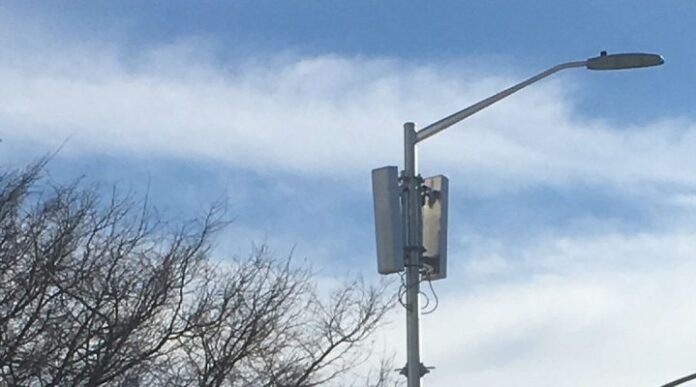Outdoor use cases for small cells and DAS range from cities to venues to suburbia
Outdoor small cells and distributed antenna systems can be used by mobile network operators to boost capacity in crowded urban areas, to add capacity at high-value venues, to extend coverage to remote areas and to cover communities that are not receptive to cell towers. RCR Wireless News recently outlined six case studies that illustrate these use cases.
1. Citywide network in Atlanta
Crown Castle is using its fiber footprint to connect several Atlanta-area systems into one small cell network. The company first brought DAS to Atlanta several years ago in order to cover suburban neighborhoods, and now those systems are becoming part of a larger network. The new network uses pole-mounted remote radio units attached to antennas designed to support one carrier.
A second carrier is set to join the system in the months ahead, and is expected to use a centralized radio access architecture, meaning the radio node will not include the baseband processing functions; those will be centralized at a remote location. This architecture minimizes the amount of equipment on each pole, which helps with zoning approvals and can leave the door open for a second carrier to potentially attach to the same pole. Crown Castle said eventually both carriers on the Atlanta network will move to a C-RAN architecture.
2. Verizon C-RAN deployment in San Francisco
Verizon Wireless is in the process of deploying 400 small cells in San Francisco, with the baseband processors housed in five remote hub locations. The carrier prioritized its deployments for Super Bowl 50 in order to ensure the parts of the city expected to see the most traffic would be able to handle the capacity. Dark fiber is used to connect the nodes to the hub locations.
Each remote node will include two Ericsson micro radio units. One radio will support Verizon’s 1.7/2.1 GHz frequency band with the other supporting the 1.9 GHz frequency band. Each node will also include an antenna and wavelength division multiplexing equipment when multifiber pairs are needed.
3. Indianapolis Motor Speedway
JMA Wireless deployed its Teko DAS system for Verizon Wireless at the world’s largest sporting venue ahead of last year’s Indy 500 race. JMA’s Todd Landry describes it as “a very highly distributed, low power remote system” optimized for maximum capacity.
“We did not use high power amplifiers,” said Landry. “These are fairly low power amplifiers and [multiple-input/multiple-output] configuration and small sectors that allow us to optimize the performance to each of the users.”
Landry explained the DAS headend is fed by centralized radio access units deployed on site. The headend is said to deliver 59 MIMO sectors to 142 individual remotes in 71 locations, which feed into 300 antennas.
4. Multicarrier DAS in Maryland
This system started out as a Sprint DAS, but now supports AT&T Mobility and Verizon Wireless as well. Sprint never operated the DAS, instead it was owned and managed by NewPath Networks. After Crown Castle bought NewPath Networks, it added two more carriers to the system.
The Potomac South DAS is in Montgomery County, Maryland, which is near Washington, D.C. The community is not enthusiastic about cell towers, so the DAS is a good solution for this area. It is comprised of 21 nodes. When the two new carriers joined the system, a new antenna and a new radio cabinet were added to each node.
5. Underground cells in Switzerland
These underground cells aren’t part of an espionage network; they are part of Swisscom’s mobile network, optimized to boost capacity without breaking the bank. Swisscom already had access to underground conduit so the carrier worked with the antenna experts at Kathrein to create an antenna that sits below a specially-designed manhole cover. An Ericsson micro remote radio unit is also placed underground in special casing permeable for radio waves, but not for water or dirt.
Swisscom said it has been quite happy with the small cell trial even though an underground location is obviously not ideal for coverage. The cells in Bern, Lausanne, Zurich and Basel have increased network capacity in the most crowded parts of those cities without requiring the carrier to petition for the right to attach to poles.
6. Berlin Fan Mile
The Berlin Fan Mile is one of the world’s most popular New Year’s Eve destinations, but the road connecting the Victory Column to the Brandenburg Gate is also near other places where carriers see a lot of traffic. Vodafone and Telefónica decided to work together to deploy Cobham Wireless’s digital DAS in time for New Year’s Eve 2016. The carriers made their deadline and the DAS is now ready for other events and venues.
“Following the successful launch of this service we will now look to expand the scope of the system to utilize the full capabilities of this technology and shift the capacity from the base station hotel to other sites as required,” said Vodafone’s Enrico Schadock, head of network planning for the carrier at the time of the deployment. “We are immensely proud to lead the way with this new technology and provide our customers with high-bandwidth services no matter how challenging the environment.”
Read the full case studies here.

